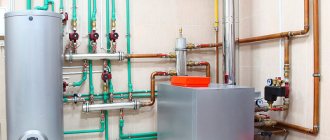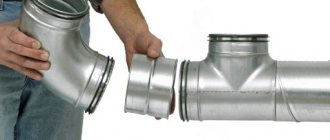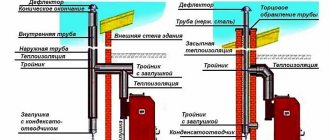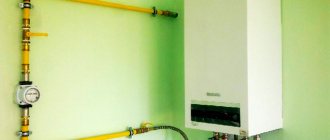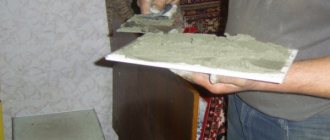Gas is considered the most cost-effective type of fuel in terms of efficiency. Even if there is no gas main line to the holiday village, many owners of country houses use gas tanks, which, from an economic point of view, is often more profitable than using other types of fuel. In any case, you need to know the rules for connecting a gas boiler in a private house, which strictly regulate all the nuances of installation and operation of the equipment.
A modern gas boiler with automation is a rather complex system, the installation and debugging of which requires specialized knowledge Source sovkalmykia.ru
Is it possible to install the equipment yourself?
In short, the installation of a gas boiler in a private house can be carried out by anyone, but commissioning of the equipment - acceptance and testing must be carried out by specialists from the gas service; connecting a gas boiler in a private house and operating it without their permission is impossible.
It is safest to entrust the installation of gas equipment to qualified representatives of a specialized organization. Only they will be able to carry out the necessary work competently, in accordance with the requirements of SNiP, and ensure the safe operation of the equipment. In addition, a competent specialist always works under a contract, which specifies who carried out what work, when and what.
Main types of gas boilers
Manufacturers of gas equipment offer customers different types of heating boilers running on blue fuel. They are designed for heating any area and, according to the type of installation, are divided into floor and wall.
The first of them are powerful, reliable and durable “flagship models”, designed for installation in houses with above-average square footage. There is only one general drawback of such models - they will have to be equipped with a separate room.
Modern floor-standing gas boilers Source vsemixfight.ru
Wall-mounted gas boilers are an excellent alternative for a small private home: they do not require a separate room - such devices are compact and versatile. In addition, their installation does not impose increased conditions on the load-bearing capacity of the wall - it only requires a layer of non-combustible material between the boiler and the base.
Requirements for the boiler room in the house
If the boiler output is more than 30 kW, then it must be installed in a separate room. All information on how to install a gas boiler in a private house is given in the SNiP standards, where there are clear requirements for the arrangement of a boiler room for heating equipment powered by fuel combustion.
You can place the boiler room in the attic, in the basement (basement) or simply in a separate room of the house. A mandatory requirement for this is free passage into the room, sufficient illumination and the arrangement of a rigid base.
In addition, installing a gas boiler in a private house requires the following boiler room:
- volume of at least 13.5 m³ for boilers with a power of 30-60 kW and over 15 m³ for models with higher productivity;
- convenient access to equipment.
Properly designed boiler room for a private home Source teploknam.ru
- within an hour, ventilation should provide three air exchanges;
- walls and ceilings are made of non-combustible material;
Important! Heating boilers are located at a distance of at least 0.5 m from flammable surfaces. And the partitions comply with the fire resistance standard RE1 45, that is, they must resist open fire for 45 minutes.
Useful tips
Even a well-calculated and constructed flue gas discharge channel can work effectively only with regular cleaning.
It is strictly unacceptable to use wood, plastic materials and polystyrene foam, any wallpaper and textile materials in the decoration of the boiler room. Emergency cooling valves that are independent of the electrical network can be of great benefit. If the coolant warms up to 95 degrees, part of it is redirected to the sewer, while the same amount of cold liquid is supplied inside. Without such devices, it is undesirable to operate high-power boilers. If it is decided to install a heat accumulator, then gravitational circulation must be ensured between it and the boiler. Even in a big city, not to mention remote areas, it is necessary to install uninterruptible power supply systems. They will help maintain the movement of the coolant even when the power supply is turned off. As soon as the supply is restored, the energy storage device will begin to charge. The required power of the backup device is 150% of the total peak consumption of all protected electronic components.
Tips for choosing a solid fuel boiler are in the next video.
Requirements for a boiler room in a separate building
The advantages of a separate boiler room are increased safety, reduced noise levels and the ability to use the freed up space for other purposes. The disadvantage will be that the heating system will become more expensive, since it will be necessary to install an additional thermally insulated pipeline branch.
At the same time, the requirements for such boiler houses are as follows:
- separate foundation ;
- concrete base for the boiler;
- forced ventilation , which should provide three air exchanges within an hour;
- fulfillment of requirements regarding the size of the boiler room;
- no more than two heating devices can be installed in one room
- doors to the street should open outwards;
SNiP requirements for the external boiler room of a private house Source karelia-dom.ru
See also: Catalog of companies that specialize in insulating country houses.
- wall surfaces and ceilings are made of non-combustible material;
- the presence of a window with a transom for daylight and emergency ventilation - the area of the window opening must be suitable for the volume of the room (0.03 m2 per 1 m³);
- presence of a chimney , if it is needed for the device being installed (for wall-mounted devices with a capacity of less than 30 kW, a coaxial pipe is allowed to exit through the wall).
A sewer pipe is also connected to the boiler so that water can be drained from the system when it is replaced.
Connecting the unit to the heating system
After completing the installation of the solid fuel boiler and smoke exhaust system, the next stage of work will be the so-called piping. When performing this, one rule must be strictly observed: during operation of the heating unit, under no circumstances should cold water enter it. Especially one in which the heat exchanger is made of cast iron.
If this happens, the walls of the boiler will immediately become covered with condensation moisture. The reason for this will be a sharp temperature change. This liquid is dangerous because upon contact with carbon deposits deposited on the sides of the boiler, it turns into a viscous and dense layer of plaque.
Sticky deposits are quite difficult to remove from the surface of the boiler walls; moreover, it significantly reduces the efficiency of the heating unit. To minimize the process of condensate release when burning solid fuel in a boiler, you can follow a standard piping scheme with a three-way valve and bypass when setting the coolant to a stable temperature of 50-55 degrees.
Thus, the water in the system will move in a circle until it reaches the above-mentioned temperature. And after that the valve will begin to let cold water into the system.
When tying a solid fuel unit, it is important to take into account the features of a particular model by studying the manufacturer’s instructions. Thus, it is important to carefully connect the control unit and burner. Sometimes boilers of European brands are equipped with an automatic fire protection system connected to the central water supply.
In order not to make mistakes during the installation of a pellet boiler, it is necessary to obtain technical advice from official representatives of the boiler manufacturer. It is important to install all components of the solid fuel system in accordance with the relevant instructions.
After installing the system, it must be tested by filling it with water to create a pressure of 1 bar. And then check the operation of the boiler with a test fire
Basic requirements for smoke exhaust and ventilation ducts
The room where the gas boiler is located must meet the necessary requirements, and not only the width and length of the room is regulated according to the power of the equipment, but also the size to the ceiling, which must be at least 2 m.
A ventilation duct must be installed in the boiler room; for this purpose, a hole with a cross-section of at least 0.02 m2 is provided.
The location of gas boilers corresponds to the installation conditions of the chimney. In this case, the parameters of the latter (height, channel area) in relation to the installed gas equipment must be strictly observed.
Chimneys for a gas boiler in a private house Source pinterest.ru
The size of the internal cross-section of the smoke outlet pipe is made the same or slightly larger than that of the device. According to NPB-98, inside the chimney opening the air flow speed should be 15-20 m/sec, and such draft can be ensured with a chimney pipe height of about 5 meters.
Important! Smoke must not be vented into a duct provided for ventilation. In boiler rooms that have a standard hood, air exchange should take place due to the incoming flow from outside the room and, partially, as a result of its penetration from adjacent rooms.
Installation work on chimney installation
The procedure for installing a heating boiler on a special foundation or floor is extremely simple. It consists of simply setting the thermal unit to the position in which it will continue to work. Next, its location needs to be leveled by adjusting the legs, or special metal linings.
But it is not at all necessary to ensure that the axes of the chimney pipe and the corresponding hole in the wall coincide during the installation process. Here the alignment can be easily adjusted by adjusting the knees.
In order to avoid possible problems associated with the appearance of condensation during the operation of the boiler, it is advisable to construct the chimney of a solid fuel boiler from insulated sandwich pipes, or, as an economical option, assemble the structure yourself from pipes wrapped in basalt fibers.
The simplest chimney option in terms of both design and installation would be an attached-type chimney duct adjacent to the house from the outside
Installation of this type of chimney is carried out as follows: the pipe is attached to the wall in a vertical position, and the gas duct from the solid fuel boiler is connected to it via a tee.
As for the installation of a chimney in wooden houses, the hole in the outer wall or roof is made in strict accordance with fire safety rules.
First, an equilateral opening is cut out in the partition, and the dimensions of its sides must exceed the dimensions of the internal chimney pipe by 380 mm. from each side. For example, we have a channel with a diameter of 100 mm and a sandwich pipe, the insulation thickness of which is 500 mm. In this case, the size of the opening will be: 100 + 380 x 2 = 860 mm.
Next, the installation of a passage unit made in the form of a box made of zinc-coated steel is carried out. A sandwich pipe is pulled through this box, and the voids surrounding it are filled with basalt wool. The final operation will be to secure the assembly cover located outside.
When performing installation work, it is worth remembering that it is easiest to lay a chimney duct in a brick wall or a foam block wall using a seal and a steel sleeve.
The diagram for assembling and connecting an attached chimney from a sandwich is simple and unpretentious, and therefore its implementation is within the power of anyone
However, during the installation of the chimney duct, the following requirements must be observed:
- the pipe should be turned no more than three times, and its minimum height, calculated from the grate of the solid fuel unit, should be at least five meters;
- the sections of the chimney pipe must be connected so that rainwater flows down the outer wall, and condensation moisture flows down the inner wall;
- the horizontal part of the pipe must be installed at a slope towards the boiler.
At the bottom of the chimney, it is necessary to install an inspection hatch and a tank to collect accumulated condensate moisture. And in order to avoid the intersection of the chimney with the roof eaves, the latter can be wrapped around the pipe by using two adapters at 30 degrees.
It is best to lay the gas duct inside the house according to the proposed scheme. In this case, he will perform his direct functions flawlessly
During the installation of the chimney, it is necessary to ensure that the joints of the chimney sections do not coincide with the placement of the pipe fasteners to the wall. It is advisable to place a protective cap or a rotating weather vane on the top of the chimney.
The height of the section of the chimney that rises above the roof depends on the distance between the chimney and the ridge. The diagram shows minimum height standards, the value of which may be affected by local conditions, for example, a tall tree next to the house on the leeward side
When working on creating a smoke ventilation system, it is worth remembering that the head of the chimney pipe should not be located in the zone of wind pressure of any of the houses (both your own and neighboring ones). And in order for the draft to always be consistently good, the chimney pipe must be installed at the level shown in the above diagram.
For ease of maintenance and cleaning of the heat exchanger of a solid fuel unit, it is necessary to create access to the boiler from all sides from where these actions are planned. The ideal option would be to create a meter gap in front and on the side and rear walls of 60 cm. The minimum of these gaps should be 25 cm.
When installing a solid fuel boiler, you should remember that it is strictly prohibited to connect the gas duct of the heating unit with the brick wells of the ventilation lines of the house passing through the internal walls.
On the eve of purchasing and installing a solid fuel boiler, you should carefully check its height with the height of the future boiler room. It is also worth pre-calculating the placement of other large equipment, such as a heat accumulator, buffer tank and indirect heating boiler.
Gas appliance in a private home: requirements and main installation steps
To properly install the unit, you must first study the regulatory documentation and rules for performing this work. They talk about the features of installing gas appliances for the heating system.
Whatever type of boiler would have to be installed, it is imperative to comply with the requirements of certain norms and rules, such as:
- SNiP 41-01-2003 on heating, ventilation and air conditioning.
- SNiP 42-01-2002 on the gas distribution system.
- SNiP 21-01-97 on fire safety.
- SNiP 2.04.08-87 on the installation of boiler houses.
SNiP provisions contain all the necessary information for installing and starting a gas boiler Source optolov.ru
Operating rules
For safe use of gas, the connection diagram for a gas boiler in a private house must be followed. In addition, the following conditions :
- For starting the boiler only at normal humidity.
- Monitoring of technical condition by gas service specialists at least once a year.
- Installing a fine filter on the return pipe of the heating system.
- Natural or artificial ventilation in the boiler room.
- Compliance of draft in the chimney pipe with the requirements (10-20 m/sec).
In the event of a leak, promptly report to the emergency gas service.
conclusions
Of course, there is no single instruction for all cases that would describe in detail how to heat a two-story house from a boiler step by step. But there is an action plan that is common to everyone (and not just the owners of two-story mansions). It includes 3 main parts:
- Preparatory. She is the most responsible, and therefore takes a lot of time, but the result justifies this investment.
- Technical. Partially it is still carried out by external specialists.
- The final one. This includes installation and configuration of additional devices, test run of the system, monitoring of operation, etc.
If you go through each stage without errors, the heating in the house will work without failure for at least 20 years (as practice shows). Subject to annual maintenance of the equipment, of course.
Maintenance
Preventive measures for routine inspection of gas boilers include the following types of work :
- Checking the valves of the external and internal gas pipelines (disassembling, applying lubricant).
- Inspection of thermostats on floor-standing boilers.
- Washing or replacing filter elements.
- Inspection of nozzles , checking the tightness of the door, the operation of the igniter on floor-standing devices.
- draft control
- ice build-up in winter .
All components that have been subject to wear during operation must be replaced.
On a note! After completion of the repair and before starting the heating system, the gas service worker checks the tightness of all connections in the line. Usually a soap solution is used for this.
A competent preventive inspection will not only increase the service life of the equipment in use, but will also reduce gas consumption.
Repair and maintenance of gas equipment Source sanmaster62.ru
Floor type
Installing a floor-standing boiler is also not difficult, you need:
- Prepare a strong pedestal that can support the weight of the boiler. This is usually done by pouring a concrete solution, sometimes a sheet of galvanized iron is securely laid on the floor.
- Install the boiler, leveling its position using a building level.
- Connect the chimney to the unit, check the draft if there is no forced exhaust.
- Connect the device to the heating system by installing a filter at the end of the outlet line, i.e. just before the entrance.

